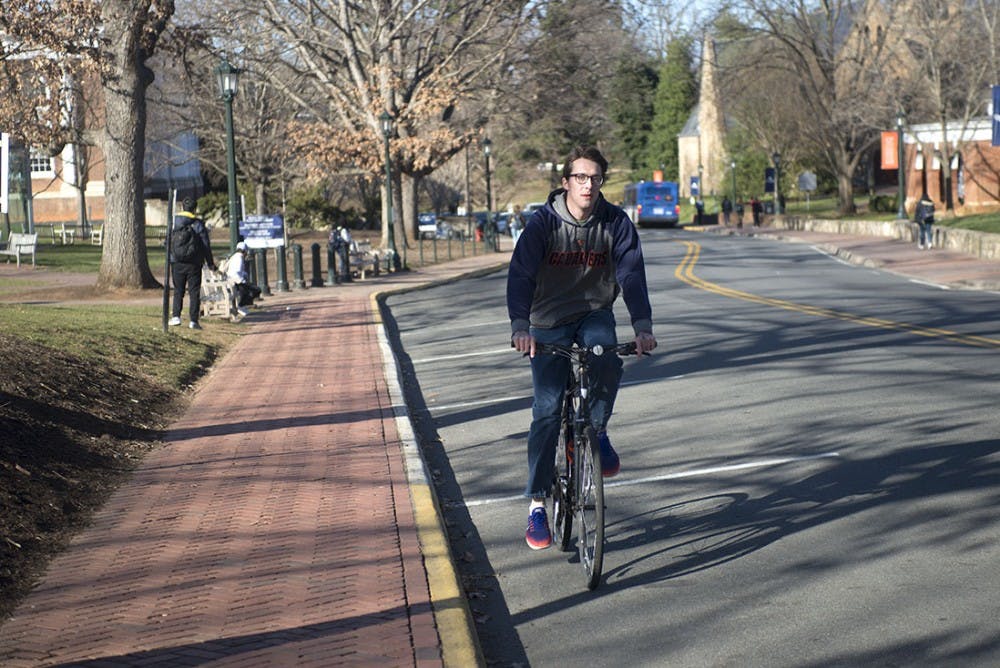The University plans to improve biking infrastructure around Grounds and the North Research Park in upcoming years. However, there are currently many barriers to biking that prevent more students and faculty from choosing this mode of transportation.
“The interesting thing about wanting to bike but having kids is that I often times I don’t bike to work because I have to do things like coach a soccer team or pick up someone from school,” said Schaeffer Somers, an associate professor of architecture and public health. “So even though I live really close and teach about the merits of biking and walking, it is hard.”
Phoebe Crisman, an associate professor of architecture and director of the Global Studies Environments and Sustainability Program, said that having a more adequate biking infrastructure that makes it safer to bike would encourage the people who currently don’t bike due to safety concerns. According to Crisman, the biking infrastructure is not good once you leave the University, which is an issue since many students and faculty don’t live on Grounds.
For instance, the biking infrastructure on West Main Street towards downtown stops and starts suddenly, and bikers who are following bike lanes are thrust into traffic and a state of panic when the bike lane abruptly ends. Thus, according to Crisman, it is important to construct continuous bike lanes in order to improve biking infrastructure.
With a lack of turn signal at the Alderman-McCormick intersection and busy periods between classes with a lot of pedestrians, biking can be quite difficult for students. According to second-year College student Sam Powers, at locations like 14th Street and The Corner, biking can be a “nightmare, especially if you are really tired.”
“Honestly, I do not think that U.Va./Charlottesville is as biker friendly as everyone suggests,” Powers said. “So Grounds itself does not really have bike lanes and being in the same lane as a bus can truly be frightening.”
According to Somers, the unique topography and small-town nature of Charlottesville makes it difficult to implement good biking infrastructure, such as setting up bike trails or separated bike lanes.
As co-chair on the University Committee on Sustainability, which makes recommendations about how to make the University more sustainable from an operational standpoint, Crisman said that the University supports increasing sustainable modes of transportation, however making changes to biking infrastructure is not entirely within the University’s control.
“The public roads are owned by the state of Virginia, so the collaboration between VDOT and the University and City of Charlottesville is required to make those kinds of changes,” Crisman said.
While it is true that the public roads are owned by a variety of entities ranging from the City to country to state, Sarah Littlefield, Alternative Transportation outreach coordinator for the University stated that there are several improvements to the biking infrastructure currently in the works, in conjunction with the Transportation Working Group in the Office for Sustainability.
“We're coming up with integrating [biking] infrastructure into a comprehensive plan with the Engineering School,” Littlefield said. “We've been talking to people from the Office of Architecture [and] the Facilities Planner for the Engineering School, on adding larger and more permanent cycling infrastructure on either side of the Engineering School, like Whitehead Road by Rice Hall, and also McCormick Road.”
In addition, Littlefield said that she is working to address the “low-hanging fruit” of biking infrastructure issues, such as ensuring that the bike repair stations are functioning and that bike racks are well-placed and in good condition. Other future projects include adding “sharrows”, or “share the road” arrows on McCormick Road and changing gate arms to make way for larger bike lanes.
Littlefield said that the University has been promoting the UBike program, and saw a 50 percent increase in UBike trips in 2017. There are currently 125 UBikes in 19 locations, with an expansion of UBikes planned for the end of May.
According to Crisman, who has been at the University for 18 years, biking safety has improved as the number of bikes has increased over time.
“More people should ride bicycles,” Crisman said. “The more people that bike, the safer it becomes because people expect to see bikes and the relationship becomes clearer.”







